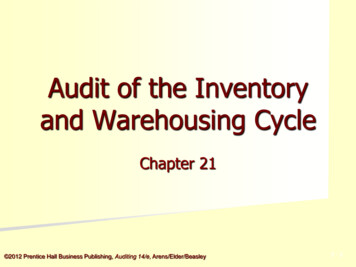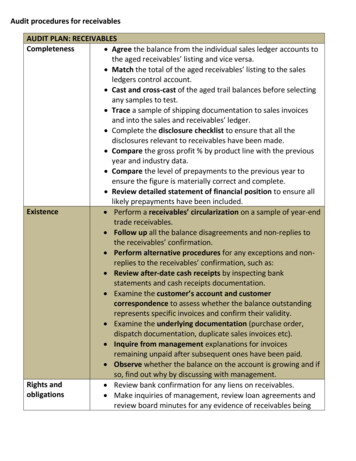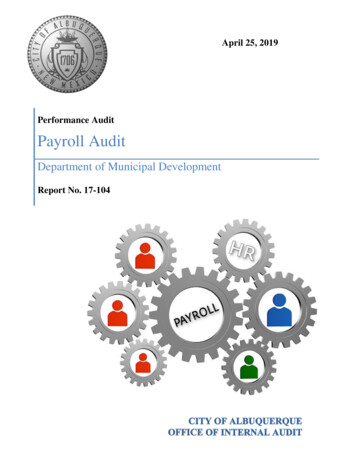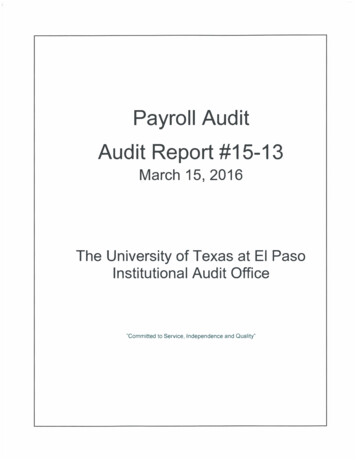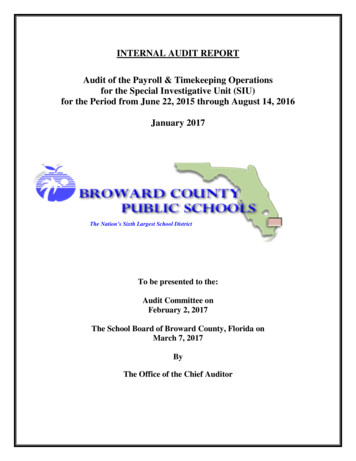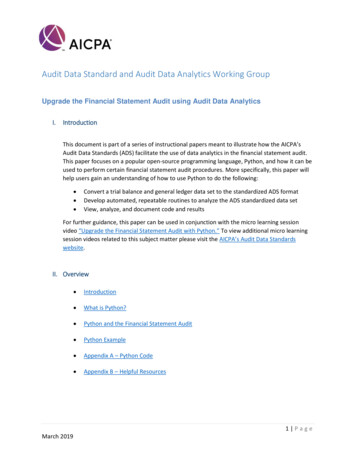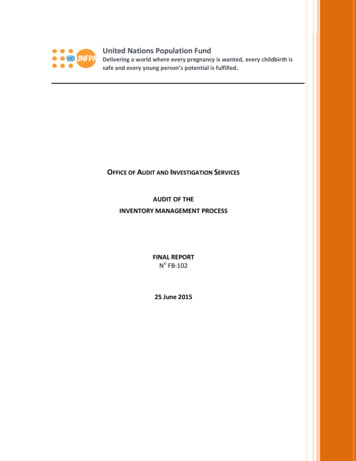
Transcription
United Nations Population FundDelivering a world where every pregnancy is wanted, every childbirth issafe and every young person’s potential is fulfilled.OFFICE OF AUDIT AND INVESTIGATION SERVICESAUDIT OF THEINVENTORY MANAGEMENT PROCESSFINAL REPORTNo FB-10225 June 2015United Nations Population Fund – because everyone counts
AUDIT OF THE INVENTORY MANAGEMENT PROCESSTABLE OF CONTENTSEXECUTIVE SUMMARY . 1II. BACKGROUND . 7III. DETAILED FINDINGS . 10A.PROCESS GOVERNANCE. 10Good practices identified . 10Define more clearly the ultimate accountability for the inventory management process as well as theroles and responsibilities of actors involved in the process . 10Promptly release the planned update to the Inventory Management Policies and Procedures manual andextend its scope to cover additional operational areas . 12Further clarify the activities assigned to Inventory Focal Points and develop standard operatingprocedures, tools and a training programme to support their functions . 13B.ORDER TRACKING AND CLEARANCE . 15Improve the effectiveness of the order tracking process and systems . 15Implement managerial oversight controls to identify shipments not timely cleared from customs . 16C.RECEIVING AND INSPECTION. 17Significantly enhance receiving and inspection controls . 17D.WAREHOUSE MANAGEMENT AND INVENTORY CONTROL . 19Good practices identified . 19Provide information and tools for monitoring the effectiveness of warehouse management and inventorycontrols . 19E.DELIVERY AND DISTRIBUTION . 21Good practices identified . 21Consistently document transfer of control over inventory to implementing partners . 22Monitor inventory distribution and availability on a regular basis . 22F.INVENTORY ACCOUNTING AND REPORTING . 24Good practices identified . 24Promptly release into production the new Atlas Shipment Tracking module . 24Expense inventory procured at the time of hand-over to implementing partners . 26ANNEX 1 . 27GLOSSARY . 29Office of Audit and Investigation Services
AUDIT OF THE INVENTORY MANAGEMENT PROCESSEXECUTIVE SUMMARY1.The Office of Audit and Investigation Services (OAIS) performed an audit of the UNFPA inventorymanagement process activities conducted in the period from 1 January 2011 to 30 November 2014.Background2.The supply to programme countries of reproductive health commodities, medical equipment andutensils, dignity and hygiene kits and other inventory items constitutes a significant component ofUNFPA’s programme, driven by UNFPA’s strategic goal of achieving universal access to sexual andreproductive health, realizing reproductive rights and reducing maternal mortality, and by key initiativessuch as UNFPA’s Family Planning Strategy 2012-2020, “Choices, not Chance”, and the Global Programmeto Enhance Reproductive Health Commodity Security.3.In the context of these initiatives, UNFPA supplied programme countries with inventoryprocured at a cost of approximately USD 650 million for the period from 1 January 2011 to 31 December2013. In addition, UNFPA maintained inventory under its control, as reflected in UNFPA’ statement offinancial position, with a value of USD 46.5 million and USD 35.7 million as at 31 December 2013 and2012, respectively.Methodology and scope4.The audit was conducted in accordance with the International Standards for the ProfessionalPractice of Internal Auditing, which require that internal auditors plan and perform the audit to obtainreasonable assurance on the adequacy and effectiveness of the governance, risk management andinternal control processes in place. The audit included reviewing and analyzing, on a test basis,information that provided the basis for the audit conclusions.5.The scope of the audit included the review of the inventory management process policies andprocedures and governance arrangements, as well as the application of analytical review procedures onthe information available in the procurement, order tracking and inventory management systems. Theaudit scope also included assessing controls in place and the level of compliance with inventorymanagement policies and procedures and, for those areas not covered by such policies and procedures,the level of implementation of expected good practices. The audit covered 11 country offices visited inthe period from 1 August 2013 to 30 November 2014, which supplied reproductive health commoditiesand other inventory items procured at a cost of approximately USD 97.0 million. In addition, the auditincluded the testing of a representative sample of inventory transactions managed by those officesamounting to approximately USD 32.0 million.Audit rating6.The audit indicates that, for the period covered, the risk management performance of theinventory management process was ‘Partially Satisfactory’, which means that governance, riskmanagement and internal control processes were adequately established and functioning well, but oneor more issues were identified, as discussed in the ‘Detailed Findings’ section of this report, that maynegatively affect the achievement of the objectives of the process should they not be addressed bymanagement. Ratings by key audit area are summarized in the following table.Office of Audit and Investigation ServicesPage 1 of 29
AUDIT OF THE INVENTORY MANAGEMENT PROCESSAudit ratings by key audit areaProcess governanceUnsatisfactoryOrder tracking and clearancePartially satisfactoryReceiving and inspectionPartially satisfactoryWarehouse management and inventory controlPartially satisfactoryDelivery and distributionUnsatisfactoryInventory accounting and reportingSatisfactoryKey findings and recommendations7.The audit identified a number of good practices implemented by UNFPA, as well as areas thatrequire management attention, some of a strategic nature and other related to operational andreporting matters. Overall, the audit report includes 21 high and medium priority recommendationsdesigned to help UNFPA improve its inventory management process. Of the 21 recommendations, 3 areof strategic nature, 17 refer to operational matters and the remaining one is related to reporting.Good practices8.The issuance of the Inventory Management Policies and Procedures manual in November 2012represented an important milestone by providing the framework for a more effective inventorymanagement. From that point on, UNFPA has continued to take steps, primarily under the leadership ofits Finance Branch, to enhance the capacity of Inventory Focal Points and other personnel involved ininventory management activities, as well as to enhance the systems used to track inventory flows andreport inventory balances.9.The audit also noted an effective management of the inventory held by the ProcurementServices Branch, and the regular completion of commodity availability surveys for countries supported bythe Global Programme to Enhance Reproductive health Commodity Security, which provide invaluableevidence that can be used by UNFPA country offices and implementing partners to enhance theeffectiveness of their inventory management processes.10.With regards to financial reporting, the audit noted that UNFPA implemented a process thatallows it to report inventory balances in compliance with the requirements of the International PublicSector Accounting Standards.Strategic level11.At the strategic level, the audit pointed to the need to define the ultimate accountability for andownership of the inventory management process, and to better define the roles and responsibilities ofthe different business units and managerial roles involved in the process. The audit also identified theneed to expand the scope of the inventory management policies and procedures, in order to provideguidelines that would contribute to a more effective execution of operational inventory managementand control activities.Office of Audit and Investigation ServicesPage 2 of 29
AUDIT OF THE INVENTORY MANAGEMENT PROCESSOperational level12.Activities assigned to Inventory Focal Points should be more clearly defined and a mandatorytraining programme developed to provide them with the skills required for a more effective performanceof their duties.13.The order tracking, receiving and inspection processes, as well as inventory controls, need to beenhanced. Managerial oversight controls have to be implemented at country office, regional office andheadquarters level to ensure that: (i) inventory is timely cleared from customs and delivered toimplementing partners and beneficiaries; and (ii) excess inventory is timely identified and distributedwell ahead of its expiration date. In particular, regional office oversight over inventory managementactivities should be clarified and expanded.14.Of paramount importance is the need to significantly increase and enhance monitoring of thedistribution of inventory by implementing partners, to ensure that inventory promptly reaches itsintended beneficiaries and to help discharge fiduciary accountability obligations towards the donors thatfund the procurement of such inventory.15.From a technology point of view, Management needs to ensure the timely implementation ofthe new order tracking and inventory control systems, currently planned to take place in 2015, which willprovide the enhanced functionality required to help address several of the issues identified through thisaudit.16.Finally, the audit observed the need to consistently document the delivery of inventory toimplementing partners and beneficiaries, through the use of the handover and earmarking forms asprescribed by the policies and procedures in place.Reporting level17.Managements should also take prompt action to enhance the inventory accounting process, byrecording inventory transactions through the use of general ledger control accounts and expensinginventory only at the time it is delivered to the implementing partners or beneficiaries for which it wasprocured.Management response18.Management has reviewed the OAIS report on audit of the inventory management process andnoted issues and control weaknesses identified in this report. UNFPA management acknowledges thatthe combination of factors such as the importance of reproductive health commodities to theorganization’s mandate, total amount spent on commodities every year, continuous growth trend andidentified control weaknesses, all make inventory management an area that could be affected by risks ofinefficient use of resources, waste and inability to meet program goals and objectives. Managementfurther realizes that addressing these risks will require a series of actions by multiple parties withinorganization implemented over a period of time.Office of Audit and Investigation ServicesPage 3 of 29
AUDIT OF THE INVENTORY MANAGEMENT PROCESS19.In Management’s view, issues pertaining to the inventory management process can be groupedunder the following categories:a) Strategic: accountability issues and allocation of roles and responsibilities within the businessprocess;b) Operational: roles and responsibilities of Inventory Focal Points, ‘in country logistics’management, capacity building within field offices, and inventory management informationsystems;c) Compliance: adherence to mandatory procedures and compliance requirements as per theUNFPA Inventory Management Policies and Procedures manual; andd) Reporting: visibility of inventory balances throughout current strategic information systemsand data quality dashboards.20.Management believes that no single unit within the organization will be able to address all is
26.06.2015 · Inventory accounting and reporting Satisfactory Key findings and recommendations 7. The audit identified a number of good practices implemented by UNFPA, as well as areas that require management attention, some of a strategic nature and other related to operational and reporting matters. Overall, the audit report includes 21 high and medium priority recommendations


